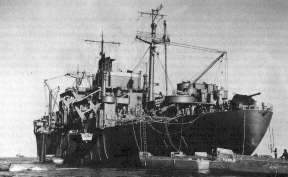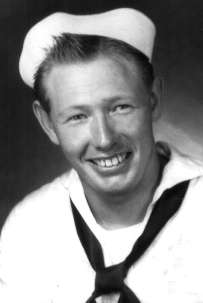|
German "Smart bombs" in 1944
|
| I received no answer. We were both U.S. Navy personnel attached to Admiral Don P. Moon's staff. He and I, along with about 70 other navy officers and men, were aboard the USS Bayfield which was manned by a Coast Guard captain and crew. The Bayfield was Adm. Moon's flag ship. Adm. Moon was commander, Group 2, 11th Amphibious Forces and we were preparing for the invasion of France, Utah Beach. |
 The attack transport USS Bayfield served as Admiral Don Moon's flagship for Force "U" during the invasion of Normandy. |
Four of us from the Bayfield took the training, two Navy Radiomen and two Coast Guard Radiomen. I recall that I was very anxious to know the nature of the mission.
First, our trainer showed us a radio Transmitter, an Oscilloscope, and a Panoramic Adapter; we were already very familiar with these items of equipment, at least I was. We used them in radio school. The transmitter had three coils for transmitting on three different radio bands; the oscilloscope was a small cathode-ray tube which produced a television type screen; the panoramic adapter was also a small screen, produced by a cathode-ray tube. "What is the mission?" I kept wondering, "What's the Mission?". Mr. Eckerd, a Navy ensign joined us later as our officer in charge.
The next person explained
to us that a German bomb hit the Cruiser USS Savannah but did not explode.
From that bomb, the technicians learned that the unexploded bomb was
guided by radio waves. He explained that the bomb could be dropped from
a German plane high up or one, two, or three miles away and guided to
a target by
radio waves to a direct it. There was a flare in the tail of the bomb
which helped in the guiding. *
"We have discovered how the bomb works," the trainer announced, "And your mission is to jam those bombs with this equipment that I have shown you. We have rigged the oscilloscope so that it will cover three radio bands instantaneously. On the oscilloscope you will be able to spot a Controlled Bomb because it will cause a "Pip" to show on the screen, a fixed pip, one that will stick straight up like a man's erect penis. All the other pips on the screen will modulate up and down because they will be voice transmissions or CW (Dots and dashes)"
He went on to tell us that when a "Bomb Pip" was spotted, the oscilloscope screen would display the approximate frequency at which time we were yell it out along with the approximate power being used by the Germans; the radioman working the panoramic adapter would tune in the exact frequency. Meanwhile, the sailor at the transmitter would insert the proper coil for the band, set the power, and pull the lever to jam the bomb, that is disrupt the German control of the bomb. We could not control, only jam.
After we worked through the procedure a few times, each of us getting a chance to operate at each position, we were ready to set up shop aboard the Bayfield and begin to train for speed; our target was to identify a "Pip", call out the approximate frequency, put exact frequency, get the right coil in the transmitter and JAM within a 10 second span of time.
Our station was in a forward forecastle, cramped, but sufficient. First we developed transparent overlays to place on the two screens. The overlays were graduated so that a frequency and power could be readily identified. Some other ships also had the "jamming" equipment and we sent each other "Pips" without previous notice as part of the training. By the first of June, 1944, we were ready to go.
How well did our system work? We had quite a number of "Controlled Bomb Pips" to show up the first late afternoon and night on June 6, 1944, D-Day. We jammed everyone that we detected. For the next four to five days we had some "Pips;" they seem to have decreased in number as the days went by. The Germans switch from pattern bombing, and dive bombing, and guided bombs to dropping mines at night. It is my opinion that the mines were more effective than the bombings. I do not know what effect our "Jamming" had. I have never seen any kind of comment or statistic regarding the operation. I did hear that a troop transport was hit by a "Radio Guided Bomb and that a destroyer was sunk from a Guide Bomb hit. Later, I heard that the plane that was assigned to lay a smoke screen for the destroyer was shot down and the German shore batteries hit and sank the destroyer. In the invasion of Southern France, LST 282 was hit by a Radio Controlled Bomb. It late in the afternoon of the first day of the operation. As the LST 282 was cruising into Green Beach to unload troops and equipment, we spotted a "Radio Controlled Bomb" PIP on our screen. We were ordered not to jam, Yes, ordered not to jam.
The reason? Apparently there was some suspicion that the ships with the jamming equipment, jammed each other at Normandy. A Navy Officer, a full Lieutenant, was sent to specifically to observe our procedure and to give us the order when to jam. When we saw the "PIP", we yelled out the frequency and the power and a coil was placed in the transmitter, ready to jam. No order to jam was given. We heard the explosion!
 At
Normandy and at Southern France, many of the wounded and prisoners-of-war
were brought aboard the Bayfield because we had a large hospital facility
and plenty of space to house prisoners. This was the case after the
LST 282 was hit. I personally talked with several of the wounded soldiers
from the LST about what happened. They said that they were out on deck
of the LST, anticipating going ashore, when they heard a "Whissch"
sound and something exploding against the side of the ship. Some were
knocked to the deck and some were knocked into the water.
At
Normandy and at Southern France, many of the wounded and prisoners-of-war
were brought aboard the Bayfield because we had a large hospital facility
and plenty of space to house prisoners. This was the case after the
LST 282 was hit. I personally talked with several of the wounded soldiers
from the LST about what happened. They said that they were out on deck
of the LST, anticipating going ashore, when they heard a "Whissch"
sound and something exploding against the side of the ship. Some were
knocked to the deck and some were knocked into the water.
Later, we learned, that two German planes were seen at a distance, just above the French horizon. I will always feel that we could have jammed that "Radio Guided Bomb", as they are technically called.
* After the war I learned that a German plane was shot down in Plymouth, England, and that the entire "Radio Controlled Bomb" equipment was on the downed plane.
Operation Tiger (see History Channel Sunday , May 13 10:00 PM E Military Blunders Operation Tiger: Disaster before D-Day
"During preparations before the June 1944 Normandy landings, the U.S. lost 700 servicemen in a landing rehearsal off the coast of England."
E-Boats Attack D-day
Rehearsal in England
April 28,
2001
Subject: EXERCISE TIGER
Today is
the anniversary of a tragedy in which the Bayfield was involved. EXERCISE
TIGER was the code name for our D-day rehearsals which took place
at Slapton Sands, England.
Slapton Sand beaches were similar to the beaches at Normandy. Our
amphibious group, with the 4th Inf. Division on board, left port on
April 27, 1944. Around 2:00 o'clock on the morning of April 28, 1944,
we were moving toward our target beach to practice landings.
GENERAL QUARTERS sounded; everyone went to battle stations, most thinking
that it was part of the rehearsal. As I went out on deck, I could
see gun fire off our stern, on the perimeter, where the destroyers
were protecting our rear. I knew that it was not a
part of Exercise Tiger.
Next morning I was on the fantail, viewing the trash and other debris
in the water. I asked an officer nearby what had taken place last
night. He said that four E-boats
got into the convey and that "we knocked them out of the water".
In the year of 1985, while watching TV in Gainesville, Florida, I
saw four German E-Boat captains being interviewed about the Slapton
Sands raid. They said that there were nine German E-Boats, that they
were looking for merchant ships when they came upon the convey. They
stated that all nine E-boats fired all their torpedoes, sank two LST's,
and got out without being hit. That's when the news broke in the USA,
1985.
Navy lost 197 men, the army lost 431 men.
Two errors were made, apparently, one by the
US Navy and one by the British Navy. As for the US Navy error, a
miss-type, typographical error, gave the wrong frequency to the
US LST's.
The British Navy sent two ships into the English Channel to keep
watch for German E-Boats coming out of Cherbourg, France. One of
the ships was a WW1 vintage destroyer. The old destroyer had to
go into port for some kind repair; it notified the British Admiralty
in Plymouth, England, but no other ship was sent to replace the
destroyer.
The one British ship in the Channel detected the German E-Boat action
and notified the Admiralty; and, since the LST's were on the same
frequency, they thought, it was assumed that all concerned were
notified. The raid was a surprise to our amphibious group.
US Adm. Don P. Moon was the commander of the amphibious group as
well as EXERCISE TIGER. Later in that year, August, 1944, Adm. Moon
shot himself in Naples, Italy.
![]()
Send Corrections, additions, and input to:
|
Visitors since
June 6, 2000 |